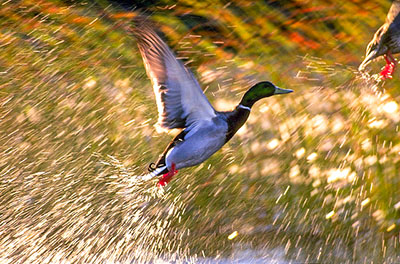Fish Report for 7-13-2018
2018 Waterfowl Breeding Population Survey Shows Continuing Upward Trend

by ODFW
7-13-2018
Website
The California Department of Fish and Wildlife (CDFW) has completed its 2018 waterfowl breeding population survey -- and it’s good news for hunters and birdwatchers alike, as the total waterfowl population in the state now tops out at over a half million, for the first time in six years.
Melanie Weaver, who oversees CDFW’s Waterfowl Program, said that duck populations responded positively to the wet winter conditions of 2017. “Given the good upland and wetland habitat conditions last year from excessive precipitation, we anticipated good production,” she said. “We are pleased to see that higher recruitment reflected in this year’s breeding population survey.”
The full Breeding Population Survey Report, which can be found on the CDFW website, indicates the 2018 breeding population of mallards increased from 198,392 in 2017 to 272,859 (an increase of 38 percent). Mallards are the most abundant waterfowl species in the state, followed by gadwall (102,637) and cinnamon teal (78,498).
Other ducks that increased in number include northern shovelers, wood ducks, redhead and canvasback. Overall, the total number of ducks increased from 396,529 to 549,180 (an increase of 39 percent).
A few duck species did decline, including American wigeon, northern pintail, lesser scaup, ring-necked duck, ruddy duck and common merganser. But Weaver gave two possible explanations for these dips. First, none of these species are considered “strong nesters” in California. They migrate through the state, but don’t breed here in high numbers. And second, the survey is designed for dabbling ducks, meaning that diving ducks (such as mergansers) are harder for biologists to detect.
The survey also included Canada geese, which dropped slightly in number, from 55,224 in 2017 to 54,851 this year. (Canada geese are detected and recorded throughout the survey; however, the number reported refers to the traditional nesting population in northeastern California.)
CDFW biologists and warden pilots have conducted this survey annually using fixed-wing aircraft since 1948. The population estimates are for those areas where the vast majority of waterfowl nesting occurs in California, including wetland and agricultural areas in northeastern California, throughout the Central Valley, the Suisun Marsh and some coastal valleys.
In 2018, the survey was flown April 24-28 in the Central Valley and May 9-10 in northeastern California. A few planned survey segments were cancelled due to weather conditions (fog in the Napa-Santa Rosa area, and high winds in a few planned transects in the northeastern part of the state). However, the crew was able to cover 97 percent of the planned survey transects.
The majority of California’s wintering duck population originates from breeding areas surveyed by the U.S. Fish and Wildlife Service (USFWS) in Alaska and Canada. Those survey results should be available in early August. CDFW survey information, along with similar data from other Pacific Flyway states, is used by the USFWS and the Pacific Flyway Council when setting hunting regulations for the Pacific Flyway states, including California.
More Reports

7-13-2018
Share your love of fishing with people new to the sport—become a volunteer fishing instructor for ODFW! ODFW will host a...... Read More
7-12-2018
ODFW will host the second annual S3DA Triple Crown archery tournament Aug. 4 at the Archery Park, EE Wilson Wildlife Area (2955...... Read More

Website Hosting and Design provided by TECK.net